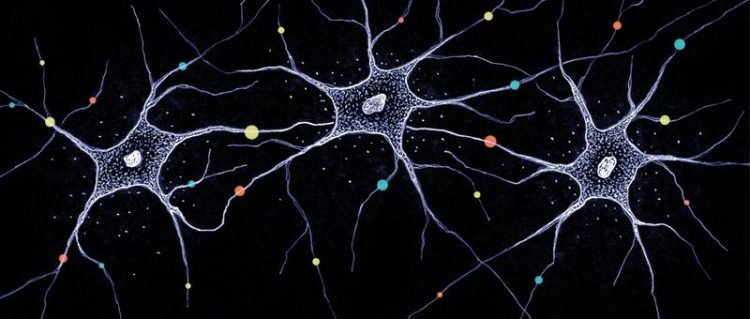Diversity in the brain – How millions of neurons become unique

Different gene variants ensure the diversity of neurons by chance. Image: University of Basel, Biozentrum
The brain is our body’s most complex organ and consists of about 100 billion neurons. For the error-free transmission of information and for proper functioning, the different cells must be programmed in a way that they connect with the correct interaction partner. Genes determine the function of the neurons. The approximately 30,000 different genes alone, however, are not sufficient to create the necessary diversity of individual neurons.
Attila Becskei’s team at the Biozentrum, University of Basel, has investigated embryonic stem cells during their maturation to neurons and developed a mathematical model of their development. It demonstrates how the observed neuronal diversity and precision is achieved by gene variants, so-called isoforms.
Gene variants ensure individuality
The different variants of single genes enable the development of a great diversity of individual neurons. “Only the combination of isoforms makes it possible that such diverse populations of neurons are generated by a rather limited number of genes.
The combinations of the isoforms are chosen randomly. This random process, however, can result in great variations in the number of expressed isoforms in the individual cells,” says Becskei. However, it is important to have the same or a similar number of expressed genes for the neurons to interact specifically with other neurons.
Exclusiveness despite numbers
The development of individual neurons is a kind of mass production with random release. Millions of neurons are formed just like on an assembly line. But how can precision be achieved in this process? The result surprised the researchers:
“Our mathematical model demonstrates that combinatorial diversity and precision are not mutually opposing phenomena but rather work together, hand in hand,” explains Becskei. Contrary to previous expectations, the number of different isoforms in the cell and exclusive precision increase simultaneously during the maturation of the neurons. In short: the more isoform variants, the more exclusive and evenly distributed they are in the individual neurons.
As each gene is expressed differently and not all have various isoforms, the findings cannot be applied to all genes. In the future, the Becskei research group plans to investigate more genes and study the strategies that ensure the individuality of neurons. Which function is linked with the uniqueness of each neuron is another question to pursue.
Prof. Dr. Attila Becskei, University of Basel, Biozentrum, Tel. +41 61 207 22 22, email: attila.becskei@unibas.ch
Takeo Wada, Sandrine Wallerich, and Attila Becskei
Stochastic gene choice during cellular differentiation
Cell Reports (2018), doi: 10.1016/j.celrep.2018.08.074
Media Contact
More Information:
http://www.unibas.chAll latest news from the category: Life Sciences and Chemistry
Articles and reports from the Life Sciences and chemistry area deal with applied and basic research into modern biology, chemistry and human medicine.
Valuable information can be found on a range of life sciences fields including bacteriology, biochemistry, bionics, bioinformatics, biophysics, biotechnology, genetics, geobotany, human biology, marine biology, microbiology, molecular biology, cellular biology, zoology, bioinorganic chemistry, microchemistry and environmental chemistry.
Newest articles

Trotting robots reveal emergence of animal gait transitions
A four-legged robot trained with machine learning by EPFL researchers has learned to avoid falls by spontaneously switching between walking, trotting, and pronking – a milestone for roboticists as well…

Innovation promises to prevent power pole-top fires
Engineers in Australia have found a new way to make power-pole insulators resistant to fire and electrical sparking, promising to prevent dangerous pole-top fires and reduce blackouts. Pole-top fires pose…

Possible alternative to antibiotics produced by bacteria
Antibacterial substance from staphylococci discovered with new mechanism of action against natural competitors. Many bacteria produce substances to gain an advantage over competitors in their highly competitive natural environment. Researchers…





















